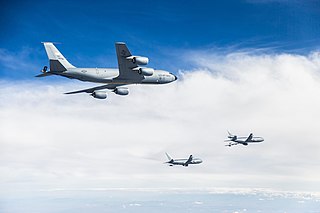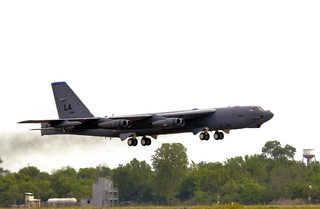
The 370th Flight Test Squadron is an active United States Air Force unit assigned to the 413th Flight Test Group, stationed at Edwards Air Force Base, California. It has been active in the flight test role since 2001.

The 32nd Air Refueling Squadron is part of the 305th Air Mobility Wing at Joint Base McGuire-Dix-Lakehurst, New Jersey. It operates the Boeing KC-46A Pegasus aircraft conducting air refueling missions. The squadron is one of the oldest in the United States Air Force, its origins dating to 19 May 1917, being organized at Camp Kelly, Texas. The squadron deployed to England as part of the American Expeditionary Force during World War I. During World War II, the squadron saw combat service as a Boeing B-17 Flying Fortress unit, assigned to the Fifteenth Air Force in Italy. During the early years of the Cold War, it was a Boeing RB-47 Stratojet strategic reconnaissance squadron as part of Strategic Air Command.

The 413th Flight Test Squadron is part of the 96th Test Wing and is based at Hurlburt Field, Florida. It performs flight testing on aircraft used by special operations forces, the Lockheed C-130 Hercules, Bell Boeing CV-22 Osprey, Sikorsky MH-53 Pave Low, Bell UH-1 Huey, and Sikorsky HH-60 Pave Hawk aircraft.

The 415th Flight Test Flight is a United States Air Force reserve unit. It is assigned to the 413th Flight Test Group of Air Force Reserve Command, stationed at Joint Base San Antonio-Randolph, Texas.

The 418th Flight Test Squadron is a United States Air Force squadron. It is assigned to the 412th Operations Group, Air Force Materiel Command, stationed at Edwards Air Force Base, California.

The 301st Operations Group is a flying component of the 301st Fighter Wing, assigned to the United States Air Force Reserve Tenth Air Force. The group is stationed at Carswell Field, Texas.

The 340th Weapons Squadron is a United States Air Force unit assigned to the USAF Weapons School. It is stationed at Barksdale Air Force Base, Louisiana. The 340th is assigned to the 57th Wing, at Nellis Air Force Base, Nevada. The mission of the squadron is to provide Boeing B-52 Stratofortress instructional flying.

The 371st Bombardment Squadron is an inactive United States Air Force unit. Its last assignment was with the 307th Bombardment Wing at Lincoln Air Force Base, Nebraska, where it was inactivated on 25 March 1965.

The 326th Bombardment Squadron is an inactive United States Air Force unit. Its last was assigned to the 4141st Strategic Wing, stationed at Glasgow Air Force Base, Montana. It was inactivated on 1 February 1963.

The 327th Bombardment Squadron is an inactive United States Air Force unit. It was last assigned to the 4170th Strategic Wing, stationed at Larson Air Force Base, Washington. It was decommissioned on 1 February 1963.

The 353d Bombardment Squadron is an inactive United States Air Force unit. It last was assigned to the 301st Bombardment Wing, stationed at Lockbourne Air Force Base, Ohio. It was inactivated on 8 June 1964.

The 352d Bombardment Squadron is an inactive United States Air Force unit. It was last assigned to the 301st Bombardment Wing at Lockbourne Air Force Base, Ohio, where it was inactivated on 8 June 1964.

The 348th Reconnaissance Squadron is an active United States Air Force squadron, assigned to the 319th Operations Group. It was activated at Grand Forks Air Force Base, North Dakota on 19 September 2011. It currently operates the RQ-4 Global Hawk, High Altitude Intelligence, Surveillance, and Reconnaissance Remotely Piloted Aircraft.

The 347th Bombardment Squadron is an inactive United States Air Force unit. It was last assigned to the 4047th Strategic Wing, and was inactivated at McCoy Air Force Base, Florida on 1 April 1963.

The 346th Test Squadron is a United States Air Force unit assigned to the 318th Cyberspace Operations Group at Joint Base San Antonio–Lackland, Texas. The squadron tests military cyberspace operation systems.

The 341st Bombardment Squadron is an inactive United States Air Force unit. It was last assigned to the 4038th Strategic Wing. It was last stationed at Dow Air Force Base, Maine, where it was inactivated on 1 February 1963.

The 342d Bombardment Squadron is an inactive United States Air Force unit. It was last assigned to the 4137th Strategic Wing at Robins Air Force Base, Georgia, where it was inactivated on 1 February 1963.

The 534th Training Squadron is an inactive United States Air Force unit. It was last assigned to the 381st Training Group at Vandenberg Air Force Base, California, where it conducted qualification training for airmen in satellite control operations and maintenance.

The 839th Bombardment Squadron is an inactive United States Army Air Forces unit. It was activated in January 1941 as the 79th Bombardment Squadron and equipped with Douglas A-20 Havoc light bombers. Following the attack on Pearl Harbor the squadron began to fly antisubmarine patrols off the Atlantic coast and over the Caribbean Sea, becoming the 8th Antisubmarine Squadron.

United States Army Air Forces formations and units in the Mediterranean Theater of Operations (MTO) were the second-largest user of the Boeing B-17 Flying Fortress during World War II. There were a total of six combat groups (twenty-four squadrons) equipped with the bomber assigned to the Theater.































